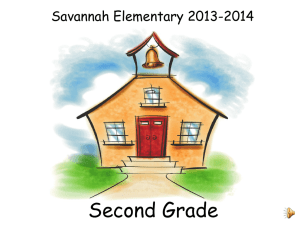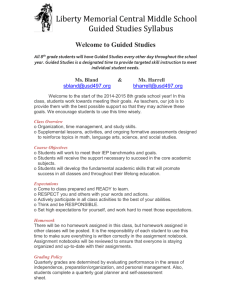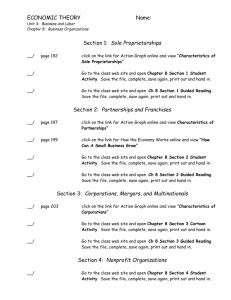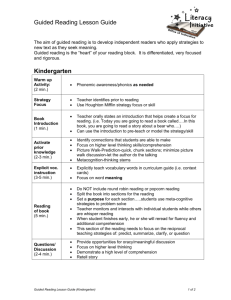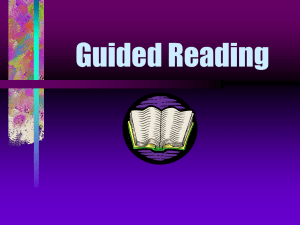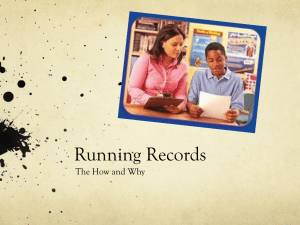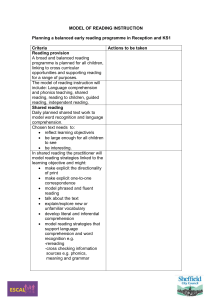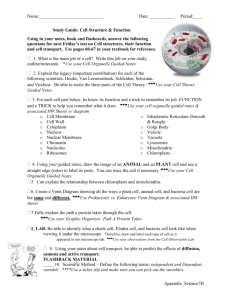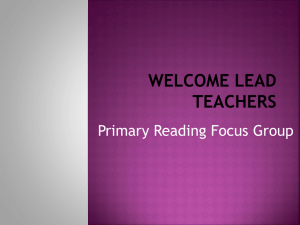Refining Your Reading Workshop session 6
advertisement
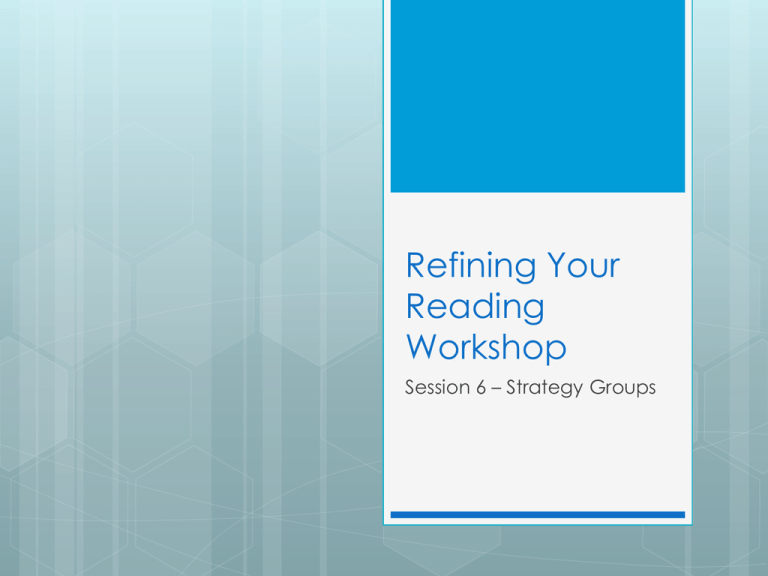
Refining Your Reading Workshop Session 6 – Strategy Groups Agenda Purposes of small groups Strategy group vs. Guided Reading group Logistics of using small groups Purposes for small groups Purposes of Small Group Instruction Read increasingly more challenging texts Read fluently with expression Read strategically Engage in meaningful, invigoration conversations about books Read with engagement and enthusiasm Questions to explore…. What were your own small group experiences with reading groups? What are the small-group structures you rely on the most in your classroom to teach reading? Strategy groups vs. guided reading groups Two types of groups… Guided Reading Group Strategy Group Children all read the same book. Purpose is to provide supported practice with text that may be difficult. Emphasis is often about the characteristics of the level of text difficulty. Children read different books. Purpose is to provide practice with a strategy the child hasn’t mastered using easy or familiar text. Teaching points are similar to mini-lessons, but reinforces strategies not being used. Where have all the bluebirds gone? Use a balance of both types. There is a purpose and use for both. Groups should be flexible in their members, and length of time spent together. Heterogeneous grouping Unintended consequences of ability grouping By the spring, children in low-ability groups show 3X as much inattentive behavior as children in high ability groups. Receive more isolated skill and drill and fewer comprehension activities. (worksheets) Have fewer opportunities to read and write. Are interrupted more often when they miscue, and not given the opportunity to learn to problem solve and self-correct. Strategy Lessons: “miniature workshops with small groups” Mini-Lesson on strategy Reading time Coaching/supporti ng use of strategy Sharing strategy uses Making inferences Tackling tricky words Self-correcting Summarizing Fluency issues Etc. Choice between guided reading and strategy groups Guided Reading Same level of text Book introduction Reading books independently Teaching point Strategy Groups Shared text – easy or instructional teaching point Name and demonstrate strategy (resembles Mini-lessons) Read books independently Spotlight Video Debbie Diller – Inferring group Jigsaw Articles Differentiated Instruction for Building Strategic, Independent Readers – Jennifer Serravallo Group A - Read Chapter 1: Beyond Reading Groups, Beyond Guided Reading Group B - Read Chapter 4 – Guided Practice Toward Independence: Strategy Lessons for Comprehension, Print Work, and Fluency p. 97 – 109 Group C - Continue chapter 4 p. 109 - 117 Jigsaw Sharing Discuss - - the article with your letter group. Chart the VIP’s of your section. Meet with your number group and share information with people who read different articles. Beyond Levels Read about each of the 12 students. (p. 43 – 44) Identify strategies students are using and neglecting. Form groups based on student needs Logistics of planning and teaching small groups Keeping the groups “flexible” REMEMBER: Groups are not permanent. Assess the students OFTEN to determine success with a strategy being taught. (running records, retellings, etc.) Move students who are meeting status. Changing groups every 2-3 weeks depending on area of focus. (comprehension, fluency, vocabulary) Creating heterogeneous groups for different time periods. (Book choices, interests, etc.) How do you assign children to groups? Skill and or instructional need Using running records and conferencing notes to notice the strategies or skills that students need to focus on. What is the best group size? Keeping groups between 2 – 5 students is optimal. This provides for more focused instruction and engages more learners. How many groups should a class have at a time? There are as many answers to this question as there are teachers! Juggling 6 – 8 small groups a day borders on the impossible and impractical constraints of daily classroom schedules. Typically, most teachers see 2 groups a day. Some primary classroom may be able to see as many as 4. Overall, having 4 – 5 groups is more feasible. How long should groups stay together? The groups should stay together until they have accomplished the purpose for forming. Some may be together for as little as 1 to 2 sessions, others may stay together for 1 to 2 weeks. Groups should not stay together for an entire year. When you sense that groups become static, consider how to deliberately shake them up to make them more dynamic. If this isn’t done, group assignments begin to feel like permanent sentences and can interfere with even the best instruction. Lesson Plan formats Keeping records – noting progress Things to discuss Consider what we have discussed about using Guided Reading and Strategy Groups within your workshop….. What will you take away from this learning?
